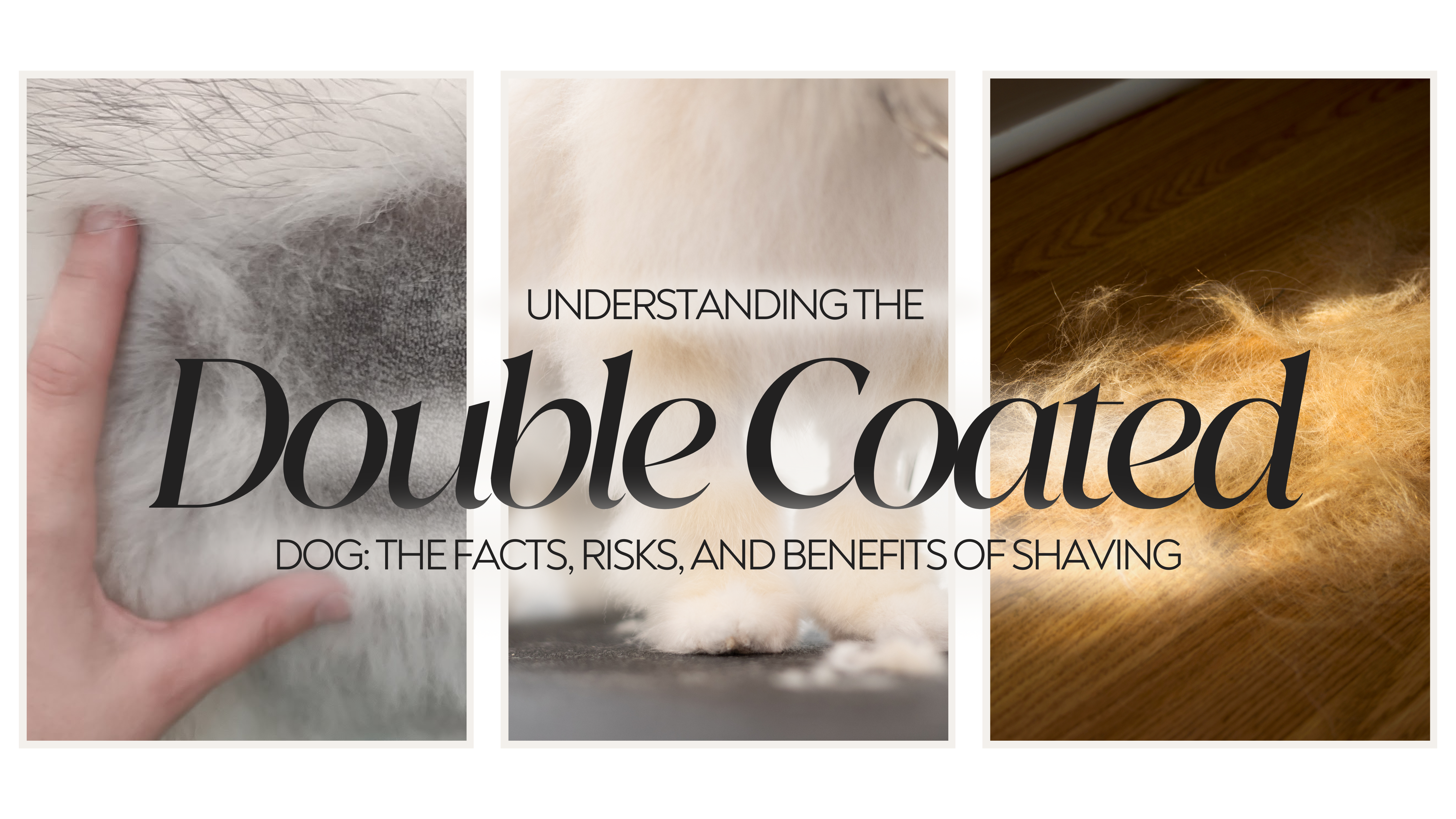Understanding the intricacies of grooming and caring for our furry companions is essential for ensuring their health and well-being. One aspect that often sparks debate among pet owners and groomers alike is the practice of shaving double-coated dogs. While there are potential benefits to shaving, it's crucial to weigh these against the risks and consider the long-term implications for our canine friends. In this blog, we explain the functions of a double coat, the potential positives and negatives of shaving and how groomers can educate their clients to make informed decisions about their pet's grooming needs.
What is a Double-Coated Dog?
Double-coated dogs have two distinct layers of fur. The first layer, known as the undercoat, is fine, fluffy and short, growing close to the skin. This layer is responsible for most of the shedding that pet owners encounter but provides essential insulation, keeping the dog warm in winter and cool in summer. The second layer, called the outer coat or guard hairs, is longer and more coarse, offering protection against external elements. Unlike the undercoat, the guard hairs do not shed. Some of the Breeds with this type of coat include Spitz type dogs, German Shepherds, Chow Chows, Huskies, Labrador Retrievers, Golden Retrievers, Pomeranians and Border Collies.

Closer Look at the Functions of Double Coats
During warmer months, the undercoat thins out to release body heat while trapping a layer of cool air, preventing overheating. In winter, the undercoat thickens to trap warm air, protecting the dog from frostbite and hypothermia. The top coat is water-resistant year-round, aiding the dog when swimming or exposed to rain and snow. Additionally, in summer, the top coat acts like built-in sunscreen by reflecting sun rays and preventing the dog’s skin from getting sunburned.

The Positives of Shaving a Double-Coated Dog
Providing Relief from Matting
A potential benefit of shaving a double-coated dog is addressing severe matting, which can occur if the coat is not regularly brushed. Mats or impacted coat can be extremely painful for the dog, leading to discomfort, skin irritation, and even infections. If an owner is unable to maintain the consistent and thorough brushing that double-coated breeds require, shaving the coat can be a more humane option than allowing the dog to suffer from a heavily matted, pelted coat. This approach can provide immediate relief from the discomfort caused by mats, allowing the skin to breathe and reducing the risk of skin problems.
To learn more about matting read here.

The Cons of Shaving a Double-Coated Dog
Weird Growth Pattern
The hair of double-coated dogs can grow at different rates depending on the breed. For example, in breeds like Cocker Spaniels, the guard hairs continue to grow all over, making regular trimming or stripping of the coat essential to maintain their appearance. In breeds such as Golden Retrievers, Bernese Mountain Dogs and Border Collies, only certain parts of the coat continue to grow, which is why trimming areas like behind the front legs, the rear end, the underbelly, chest, ears, and tail is necessary depending on the dog. However, for breeds like huskies, Labrador retrievers and German shepherds, the top coat does not continue to grow therefore if it is cut, it may or may not grow back.
Shaving these breeds poses a significant risk of their hair not growing back properly, or growing back in odd patches. Shaving can alter the texture of the coat, making it thicker or thinner than usual. It damages the natural hair growth cycle, which can result in hair taking twice as long to regrow or not growing back at all. This can leave the coat patchy, fuzzy, coarse or stringy, ultimately compromising the dog's natural protection and appearance.

Loss of Insulation
Shaving these dogs exposes their skin to sun and heat, which it is not naturally equipped to handle. Without the protection of their coat, their thin skin becomes vulnerable to sunburn and overheating. Double-coated breeds have a natural ability to regulate their body temperature; their coat helps repel excess heat. Shaving them disrupts this temperature regulation, making them more susceptible to heatstroke in hot weather and hypothermia, a potentially dangerous drop in body temperature, in cold weather.
Post-Clipping Alopecia
Post-clipping alopecia is a condition where a dog's hair takes an unusually long time to regrow after being clipped or shaved. This delayed regrowth can lead to patches of baldness and areas of discoloration scattered across the dog’s body, often resulting in an uneven and patchy coat. The hair that does eventually grow back may be of a different texture or color than the original fur, further contributing to the dog's altered appearance.
This syndrome is particularly common in Pomeranians, a breed known for its dense, fluffy coat. However, it also affects several other double-coated breeds such as Chow Chows, German Shepherds, Huskies and Golden Retrievers.
The exact cause of post-clipping alopecia is not fully understood, but it is believed to be related to the disruption of the hair growth cycle. Shaving or clipping the coat can damage the hair follicles and interfere with their normal function, leading to prolonged periods of dormancy where no new hair grows. In some cases, the hair may never fully return to its original state, leaving the dog with permanent patches of thin or absent fur.

The Coat Continues to Shed
Even if you shave down a double-coated dog, they will still shed. Many pet owners mistakenly believe that shaving their double-coated breed will reduce shedding, but this is not the case. The undercoat, which is the primary source of shedding, continues to grow and shed regardless of the coat's length. Shaving only removes the outer layer of guard hairs, which do not shed as much. As a result, the shaved undercoat still sheds, often leading to shorter but more abundant loose hairs scattered around the house. Shaving the coat can stimulate the hair follicle to cause it to produce more undercoat than normal. Additionally, shaving can disrupt the natural shedding cycle.

How to Communicate with Customers
Many customers who ask to have their double-coated dog shaved often do not have all the necessary information. As their groomer, your role is to educate them about their dog's coat. Explain the vital functions of the double coat, such as temperature regulation and protection from environmental elements. Inform them about the risks, including the possibility that the coat may never return to its original condition, and discuss post-clipping alopecia. Emphasize that shaving does not reduce shedding but can actually make it worse.
It is important to communicate this information in an educational, non-judgmental manner, understanding that many pet owners may not have done extensive research before acquiring their pet and may genuinely lack understanding of how a double coat functions.
If, after receiving all this information, the client still insists on shaving their dog, what you do from there is up to you. If the dog has been consistently shaved in the past and the damage is likely already done, you may have to do what you can to even out the coat. Ensure the owner is aware of the need for sun protection during summer and the importance of keeping their dog in a warm environment during winter if you do choose to shave the pet. This approach balances professional guidance with respect for the client's wishes and the dog's well-being.
Final Thoughts
In the complex world of pet grooming, the decision to shave a double-coated dog requires careful consideration of various factors. While there may be instances where shaving is necessary or beneficial, it's essential to approach this practice with caution and awareness of the potential consequences. By understanding the functions of a double coat and the impacts of shaving, pet owners and groomers can work together to ensure the best possible care for our furry companions, prioritizing their comfort, health and overall well-being. Through education and informed decision-making, we can continue to provide our clients’ beloved pets with the love and care they deserve.

